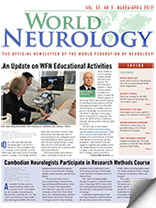By John D. England, Editor-in-Chief

John D. England
One of the prime missions of the Journal of the Neurological Sciences is to highlight activities of the World Federation of Neurology (WFN). Along those lines, I wish to remind everyone that the XXIII World Congress of Neurology (WCN) will be held Sept. 16-21, 2017, in Kyoto, Japan. The Congress will be co-hosted by the Japanese Society of Neurology and the Asian and Oceanic Association of Neurology. The theme of WCN 2017 is “Defining the Future of Neurology.” The WCN will feature a series of programs and lectures led by leading scientists, clinicians, public health experts, and policymakers from around the world. Some of the cutting-edge topics will include gene therapy, stem/iPS cell medicine, brain-machine interface, and robotics in medicine. Traditional topics of neurology and neuroscience also will be presented. I encourage all of our readers to consider attending the meeting. Detailed information about XXIII WCN can be accessed at www.2017.wcn-neurology.com/.
In our effort to inform readers of important and interesting developments in the journal, the editorial staff has selected two new “free-access” articles for our readership. This issue’s selected articles deal with cardiac transplantation in Friedreich’s ataxia (FRDA). Although ataxia is the clinical hallmark of FRDA, cardiac disease is the leading cause of death. There is no known cure for the cardiomyopathy of FRDA, and its course is independent of the neurological manifestations. For these reasons, a few patients with FRDA and severe cardiomyopathy have undergone cardiac transplantation. The results have been generally positive.
Ashley McCormick and colleagues describe their experience and long-term follow-up of three patients with FRDA who underwent successful cardiac transplantation. Although each patient experienced progression of the neurological manifestations of FRDA, all maintained stable cardiac status several years post-transplant. The patients remain alive and socially engaged at five years, eight years, and 19 years post-transplant, respectively. The authors conclude that cardiac transplantation can be a reasonable treatment for patients with FRDA who develop end-stage cardiomyopathy.
Ashley McCormick, et al., Cardiac transplantation in Friedreich Ataxia: Extended follow-up, J. Neurol. Sci. 375 (2017) 471-473. http://www.jns-journal.com/article/S0022-510X(17)30028-X/fulltext?rss=yes
In an accompanying editorial, David Pleasure reaffirms that cardiac transplantation might be a viable option for selected patients with FRDA who have life-threatening cardiomyopathy. He points out that the transplanted hearts in these and other patients have shown no signs of cardiomyopathy, suggesting that the heart disease in FRDA is independent of its other manifestations. He also outlines potential future treatment interventions for the cardiomyopathy of patients with FRDA.
David Pleasure, New hearts for Friedreich patients, J. Neurol. Sci. 375 (2017) 474-475.
